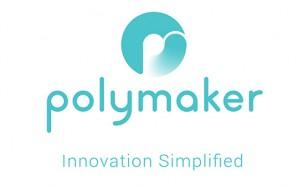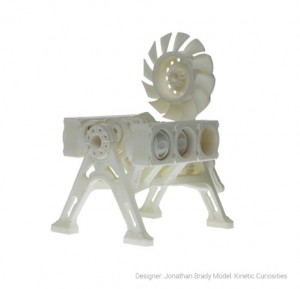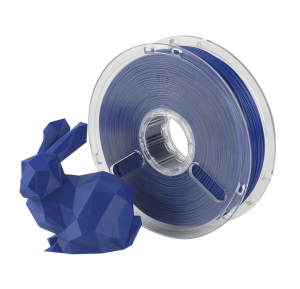 As the focus of the 3D printing industry shifts from the hobby and maker market to the industrial design and office market there has been a shift in 3D printer usability. The last few generations of desktop 3D printers have focused on streamlining, reducing the number of misprints and errors and taking the frustration out of the printing process. As machines become easier to use and more reliable, the focus has now begun to shift over to 3D printing materials.
As the focus of the 3D printing industry shifts from the hobby and maker market to the industrial design and office market there has been a shift in 3D printer usability. The last few generations of desktop 3D printers have focused on streamlining, reducing the number of misprints and errors and taking the frustration out of the printing process. As machines become easier to use and more reliable, the focus has now begun to shift over to 3D printing materials.
The most popular 3D printing material by far is standard PLA, a thermoplastic that is easy to print with, non-toxic and completely recyclable. The problem with PLA however is that it is pretty fragile, and is susceptible to moisture damage from improper storage in damp environments. For stronger models, designers usually turn to ABS, which brings with it its own host of problems and drawbacks. Despite being harder and more durable than PLA, ABS can be rather finicky to print with and requires very specific and consistent printing temperatures. It also smells terrible, and the fumes are most likely toxic to the human body
A growing number of 3D printing material manufacturers have started to shift their focus from producing standard printing materials to expanding the market with a whole range of high tech filaments. Polymaker is already well known for producing some well-regarded 3D printing materials, from their PolyMax, PolyPlus, PolyFlex and PolyWood materials, they are already changing the options available to FDM 3D printer owners. The latest addition to their lineup of advanced 3D printing materials is their new support material, PolySupport.
3D models with complex geometries tend to be difficult to print using standard 3D printing materials. Any sort of complexity or overhanging details on the model will need support material of some kind. Generally support material is added as a final step before slicing and 3D printing, and is simply made from the same material that the main model is being printed in, and these supports are connected with breakaway spots that make it easy to remove. Unfortunately ‘easy’ is very relative. While the supports may be removable, it takes quite a bit of time, presents a risk that the main model will be damaged and often leads to rough spots that need to be filed or sanded away.
 Polymaker’s new PolySupport material has been designed to easily be removed by hand without damaging the final model’s finish. Not only does that drastically reduce the amount of time that post processing takes, but it virtually eliminates the possibility of damaging the model during the cleaning process. PolySupport can be printed reliably at 220-240 °C with no heated bed required, and has also been formulated to be strong enough to be used just like any other PLA material would be, on a single extruder printer. It can even include rafting and supports made to be just as easy to remove from itself as when printed with a second material on a two extruder 3D printer.
Polymaker’s new PolySupport material has been designed to easily be removed by hand without damaging the final model’s finish. Not only does that drastically reduce the amount of time that post processing takes, but it virtually eliminates the possibility of damaging the model during the cleaning process. PolySupport can be printed reliably at 220-240 °C with no heated bed required, and has also been formulated to be strong enough to be used just like any other PLA material would be, on a single extruder printer. It can even include rafting and supports made to be just as easy to remove from itself as when printed with a second material on a two extruder 3D printer.
Check out this video demonstrating how well the PolySupport material works:
“Many designers who currently work in 3D go to great lengths to avoid using support in their projects, opting instead to create several less complex pieces to be assembled later. PolySupport overcomes this problem and, in fact, is particularly good for parts with large overhangs, preventing print failure due to lack of support. We believe that this material will strongly appeal to industrial designers who want to unleash their creativity and follow their visions,” explained Polymaker CEO Dr. Xiaofan Luo.
In addition to the introduction of PolySupport, Polymaker has also expanded its line of PolyMax PLA materials by four new colors. In addition to the already available black and white colors, PolyMax is now available in red, yellow, orange and blue. PolyMax has been rated as being more than nine times as stronger than industry standard PLA, and Polymaker says that it is even 20% stronger than most brands of ABS.
PolySupport is available in both 1.75mm and 3.0mm diameter options, costing $39.99 for each .5 kg spool of filament. All six available colors of PolyMax materials are also available in both 1.75mm and 3.0mm diameter options with each .75 kg spool of filament costing $49.99. Let us know what you think of this new generation of advanced 3D printing materials over on our PolyMax Colors and PolySupport 3D printing Material forum at 3DPB.com.
Subscribe to Our Email Newsletter
Stay up-to-date on all the latest news from the 3D printing industry and receive information and offers from third party vendors.
You May Also Like
3D Printing News Briefs, April 13, 2024: Robotics, Orthotics, & Hypersonics
In 3D Printing News Briefs today, we’re focusing first on robotics, as Carnegie Mellon University’s new Robotics Innovation Center will house several community outreach programs, and Ugogo3D is now working...
Rail Giant Alstom Saves $15M with 3D Printing Automation Software 3D Spark
3D Spark has entered into a three-year deal with the rail giant Alstom. Alstom, a transport behemoth with annual revenues of $16 billion, specializes in the manufacture of trains, trams,...
Meltio Expands Global Reach with New Partnerships in the Americas and Europe
Spanish 3D printing manufacturer Meltio has expanded its sales network across the globe. With the addition of three new partners in the United States, Brazil, Argentina, and Italy, Meltio aims...
3D Printing Webinar and Event Roundup: April 7, 2024
Webinars and events in the 3D printing industry are picking back up this week! Sea-Air-Space is coming to Maryland, and SAE International is sponsoring a 3D Systems webinar about 3D...

































